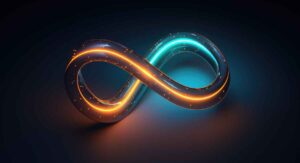DevOps has only been around for 16 years, which is recent compared to more established methodologies and procedures. However, DevOps has gained considerable traction over the past decade and a half, so learning DevOps is a prudent idea.
This article shows you how to learn DevOps, where to begin, what things you need to know, and how to implement DevOps in your organization.
Let’s begin by explaining why DevOps is so important, what it is, and how you can upskill through an online DevOps program to boost your career.
Why DevOps?
The term “DevOps” is a fusion of two words: “development” and “operations.” When using the DevOps methodology, the team owns the entire lifecycle of an application or software. The DevOps team designs, implements, deploys, monitors, resolves issues, and updates the product. The team owns the code plus the infrastructure that the code runs on.
Before the advent of DevOps, developers created software with a complex and often confusing mishmash of tools and workflows. Projects and teams were usually siloed, meaning they weren’t coordinating their efforts or sharing best practices. The old process was frustrating and inefficient, resulting in deployment logjams that cost teams time and money.
What DevOps is Really All About
Consider DevOps as a means of simplifying development and deployment and making the whole process more efficient. With DevOps, teams, tools, and workflows that were once siloed are now combined in a smooth software development ecosystem. That ecosystem lets the team plan, create, and deliver a product more efficiently, securely, and collaboratively.
DevOps increases productivity by letting developers focus on what they excel in, building excellent products instead of wasting time performing low-value work like manually checking log files. DevOps practices automate the repetitive work (e.g., running tests and deployments, monitoring production software for issues, and creating a problem-resilient deployment methodology). Developers are free to build and experiment, boosting productivity and a better product, making the company more competitive and viable. Everyone wins.
DevOps is not a technology. The whole point of DevOps is to build a culture of shared responsibility, transparency, and more timely feedback. Technology is a tool that helps the process, but buying DevOps tools without actually implementing the methodology is a waste of time and money.
Not everyone is convinced that DevOps is the last word in app development and deployment; the methodology has its detractors. Although there are cases where DevOps isn’t the best strategy, the philosophy continues growing and getting results. Let’s see where you begin your journey in learning DevOps.
How To Learn DevOps: Where Do You Begin?
Although DevOps simplifies and streamlines application development and deployment, it’s a long, drawn-out process to master. Here’s a checklist of steps you should take if you want to learn DevOps if you’re starting out as a complete novice.
- If you don’t know one yet, learn a programming language. DevOps involves some programming, so prepare by nailing down a language or two. If you’re a beginner, start with Java or Python (why not both?). Other languages include Ruby, Go, Java, and JavaScript.
- Learn operating system fundamentals. Linux is currently the most used operating system in the IT industry. Other examples include Windows, Unix, Ubuntu, Fedora, and CentOS. Familiarize yourself with OS concepts like concurrency, kernel and memory management, threading, file and I/O management, sockets, POSIX basics, and virtualization.
- Get to know the basics of terminal and shell scripting. Terminal, also known as command line or console, lets you perform many tasks without the help of a graphical user interface (GUI). Get familiar with terminal commands and basic shell scripting functions like:
- Bash or Shell Scripting
- Compilation
- Powershell/VIM
- System Performance
- Text Manipulation
- Gain a working understanding of network concepts. When you run an interconnected system of apps, servers, and resources on a network, it is crucial to learn about the networking and security concepts used to diagnose troubleshooting and network issues. If you understand networking, you can create a convenient environment to test functions and establish continuous integration and delivery pipelines. Some of the networking concepts that you should familiarize yourself include:
- TCP/IP network protocols
- HTTP and HTTPS
- SMTP and FTP
- SSL/TLS
- Network Forwarding
- Firewall and Proxy
- Learn all you can about continuous integration and deployment (CI/CD). CI/CD is an essential part of the DevOps process. CI/CD facilitates stable product deliveries while maintaining high code quality. Additionally, you should get familiar with the most popular CI/CD tools, such as:
- Ansible
- Bamboo
- CircleCI
- GitHub
- Google Cloud
- Jenkins
- TeamCity
- TravisCI
- Get comfortable with monitoring tools. Monitoring tools collect data from network devices, servers, and other services, helping you monitor basic metrics like disk space, throughput, and latency. Application monitoring tools improve efficiency and repair app bugs before users use the product. Infrastructure monitoring tools include:
- Datadog
- Grafan
- Nagios
- Prometheus
- Splunk
Application monitoring tools include:
- AppDynamics
- New Relic
- Sumo Logic
- Have some foundational cloud knowledge. The cloud plays a huge role in DevOps, and you need to understand the advantages, backing services, product requirements, and providers associated with your organization.
How Do You Start Implementing DevOps in Your Organization?
Although there is no correct way to implement DevOps in your organization, the following steps cover all aspects of a well-rounded DevOps implementation. Some organizations switch the order around, but every company has different needs and emphases.
Build a DevOps transformation roadmap
This roadmap is a step-by-step guide on initiating DevOps, allowing the organization to plan its actions upfront. This roadmap, plus any accompanying documentation, should be posted in a centralized location easily accessible to team members, stakeholders, and appropriate management. The roadmap should be rendered in a language easily understood by non-technical people. Expect the roadmap to be altered and updated due to new developments or unforeseen circumstances as the project progresses.
Choose a DevOps Toolchain
Now, it’s time to pick the best toolchain for the job. A toolchain is a collection of tools dedicated to every stage of the development process. For example, the DevOps team could choose Jira for workflow tracking and planning, Kubernetes to provide individual deployment environments, Jenkins for continuous integration, GitHub for collaborative coding, etc.
Set up tools and strategies that are conducive to cultural transformation
So, now that you have the tools and strategies laid out, it’s time to apply them and begin changing the work culture. Use these steps as a guide:
- Give the development, operations, and security teams access to the toolchain.
- Offer DevOps training to development and operations teams to give them the skills to use the new toolchain.
- Assemble and define a workflow collaboration strategy among developers, operations, quality assurance, and security teams.
- Train stakeholders and appropriate business groups on DevOps concepts so non-IT staff can learn how best to interact with development and understand any new expectations product development will place on them.
- Create documentation for the internal processes and publish it to an easily accessible central repository.
Consider a transparent, phased approach to DevOps automation
Many people are suspicious of automation, so gradually bring them on board. Don’t automate every process at once; this can be overwhelming. Instead, prioritize automation goals and let the process win over skeptics by its results.
Emphasize analytics and data
Data rules in today’s world and DevOps tools enable teams to access actionable data from across the toolchain. Harnessing that data is critical to DevOps success because it changes how IT teams communicate with others. So, set up dashboard reporting for stakeholders so the project leads don’t have to spend time creating management reports manually.
Run a small pilot project
Choose a small piece of the overall project and make this your trial run. A pilot project helps the teams and stakeholders try out their toolchains and strategies on an easily manageable project rather than tackling the entire project in one go. Choose a project with little customer contact, lowering the stakes and decreasing potential risks.
Brace yourself for continuous learning and improvement
DevOps projects are not a “one and done” affair but rather are a constantly evolving entity. Teams will learn new procedures and tactics over time, and these lessons must be incorporated into the organization’s overall DevOps strategy.
Now, let’s wrap things up with an excellent approach for how to learn DevOps.
Would You Like a Career in DevOps?
If you’d like to become part of the DevOps community, you need the right skills. This 36-week DevOps bootcamp provides the essential training to bridge the gap between software development and operations and obtain hands-on skills via industry projects in continuous deployment and DevOps tools such as Ansible, Terraform, Docker, and Kubernetes.
Glassdoor.com says DevOps engineers in the United States earn a yearly average of $138,748. So get yourself set up in a fantastic new career, or upskill your current DevOps skillset by signing up for this bootcamp, and secure your place in the fast-paced world of DevOps!
FAQs
Can I learn DevOps on my own?
Yes, but the process takes time and dedication because it’s extensive.
What are the basics for learning DevOps?
Learn programming languages, operation system fundamentals, monitoring tools, cloud computing fundamentals, networking concepts, CI/CD, and more.
Can I learn DevOps without coding?
No. Programming and coding are fundamental parts of DevOps.
Is DevOps a promising career?
Absolutely. DevOps remains a popular methodology in today’s IT environment. Although not universally accepted/liked, DevOps has been embraced by organizations and businesses such as Amazon, Etsy, Netflix, IBM, and NASA.
Is DevOps difficult for beginners?
It depends on how much background knowledge the person already has (e.g., programming languages, OS fundamentals). Learning DevOps is a big undertaking, but it can be done.






